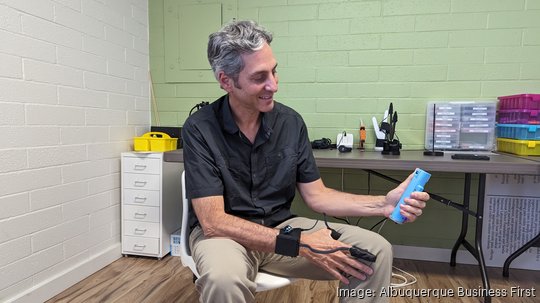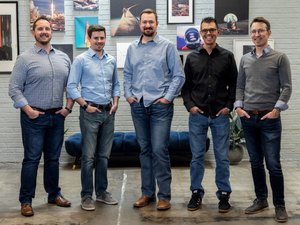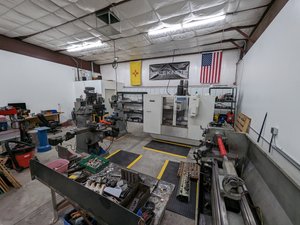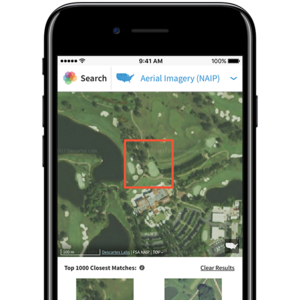
Pain is complicated — not just because physical pain in one spot is often linked to discomfort in another, but also because pain is tied up in a mix of cultural, household and workplace dynamics. In fact, researchers at Johns Hopkins Hospital have shown chronic pain patients are misdiagnosed 40% to 80% of the time.
An Albuquerque startup that recently received some public recognition is building a system it thinks can cut through that complication to help better identify patient pain.
At a community showcase event held by Roadrunner Venture Studios in June, attended by hundreds of people in Albuquerque, PainScan was voted as the No. 1 company on display by those in attendance from among dozens of others. Dr. Andru Zeller, the Albuquerque health tech startup's founder and chief technology officer, was on hand to show off the company's pain-sensing technology system.
Zeller runs a health collaborative in Albuquerque called Simply Salud. He's practiced in Albuquerque for nearly two decades with a focus on treating lower-income people at less cost than other family practices.
PainScan comes from those years of work in treating patients in Albuquerque, many of whom Zeller said suffer from chronic pain. He described carrying out "really intense exams" to identify points of pain around peoples' bodies in order for them to receive better treatment.
But without a good way to document the results, Zeller saw gaps in his approach.
"I started just trying to figure out: How could this be more efficient? That was the ultimate question," Zeller said. "This is the right approach. I was starting to identify people's pain better and starting to be able to give some better answers to them, but it was so hard to document anything. It's just so complex what's going on in the body."
That's where Zeller imagined PainScan's multi-part technology system would come in.
What's in the system?
The startup's system comes with three different components — the most ubiquitous being a haptic feedback glove that clinicians wear on their forefinger and thumb. That glove captures the amount of pressure applied during physical exams, as well as how long clinicians touch patients.
Clinician gloves are paired with a grip device that patients hold in their hands. That device is supposed to act as a substitute for verbal feedback; instead of a patient saying how much pain they're experiencing on a scale of 1–10, for instance, the patient would instead squeeze the device with more or less force depending on the amount of pain.
In addition, a camera placed above the patient captures images of the patient's body during an exam. Zeller said patients are placed in "gentle but specific" positions to contract different muscle groups.
Then, a software program turns the data received through those different components — the gloves, the grip device and the camera — into a 3D "digital twin" model of the patient with color-coded markings that depict, within inches, where a person's pain is more or less severe.
It's a non-invasive process intended to give doctors a more accurate depiction of a person's pain that would then, in turn, allow physicians to better treat those patients, Zeller said.
R&D support
He received a patent for the system in early 2022 after first applying for it in early 2019. The startup also landed a $256,000 grant through the National Science Foundation's Small Business Innovation Research Phase I program in March 2021 and has been boosted by additional funding from the New Mexico Economic Development Department, Central New Mexico Community College and the New Mexico Small Business Assistance program.
The system is still a work in progress, Zeller said. It's not yet ready for clinical use. But with more money and time, he said PainScan can continue to refine the system through research and testing.
"Our ultimate plan is to have multiple channels of pain reporting," Zeller said. "So, this would be a single channel of pain reporting. A person's facial expression would be another channel. Their sympathetic nervous system, picking up through surface EMG, how they guard, would be another channel.
"If we ultimately have multiple levels of pain reporting, we'll start to see concurrence in order to build a more holistic picture," he continued.
PainScan works with Sandia National Laboratories through the Small Business Assistance program to research how to more accurately show how hard a clinician is touching a surface using the sensing technology within the gloves. It's not perfect right now, Zeller said; readings are more accurate on harder surfaces but less accurate on softer surfaces like a person's soft muscle tissue.
Zeller said the startup's market is people who are suffering from pain and "realistically, their family members who love them, who are frustrated seeing their person suffer at home."
"Sometimes people in pain are too depressed and too hopeless to even hear a possible benefit and reach for it," he said. "So, we know that those are our two markets — the families and the people themselves suffering in Albuquerque and in Santa Fe."
Next steps
Zeller and John Mierzwa, PainScan's CEO, hope to have the first version of a functional software system ready within the next three to six months. Zeller is also applying for a second and third patent — one that's a "spin-off" of the first and another that's a "complementary piece" to it, he said.
Mierzwa said he expects PainScan to start generating revenue in the first quarter of 2024. It currently operates out of an office at Zeller's Simply Salud clinic at 202 Morningside Drive SE in Albuquerque and at a second location in Santa Fe.
It'll take between $20,000 and $40,000 to get the first version of the system ready for clinical use. While the glove technology is ready as-is, PainScan is iterating on the grip device and continuing to build out its software, Zeller said.
PainScan has one full-time employee and three contracted employees currently but could look to bring on more as its system nears market readiness.









